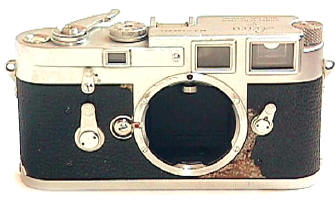

Leica M Used Buying Guide: A Not So Objective Guide
Few, if any, cameras provoke such heartfelt discussions as the Leica M's. For every opinion expressed here, you can undoubtedly find someone who has the opposite view.
I hope this guide helps you find YOUR OWN best answers, not mine.
M3 M2 M4 M5 CL M4-2 CLE M4-P M6 M6 TTL M7 MP 2003
Protecting Your M Shooting Tips Meters
NEW July 2006: List of Leica M Mount Cameras
Point of View
I am not going to reinvent the wheel here by going through all the various M models and their variations. There are a LOT of books which do that quite well. My favorites include Leica Pocket Book, Identifying Leica Cameras by Ghester Sartorius, Leica Collector's Guide by Dennis Laney, Leica An Illustrated History by James Lager, Leica, A History Illustrating every Model and Accessory by Paul-Henry van Hasbroeck, Leica M: The advanced school of photography by Gunter Osterloh, and the 15 plus editions of Leica Manual published from the mid 30's to the early 80's. The Leica Manual is a must, since it covers ALL aspects of the RF system. Collect all of them, they are great. OK, so I am assuming you know which are which. If you don't, get the books. NOT covered in this buyer's guide are the rangefinderless M cameras primarily intended for scientific use on a microscope: the M1, MD, and MDa.
It is interesting to note that three innovative design variations of the M design were introduced, and each of lived a short production life. I call them the "Orphan Leicas": M5, CL, M6TTL. I also call the plain stripped down M Leicas the "Plain Jane Leicas."
M3 1954-1966
The M3 of 1953 wasn't just a new camera, it was an entire rethinking of what 35 mm cameras should be. It signaled an entirely new level of excellence, not only for Leica, but for the entire camera industry. The M3 was so far advanced for its time that it took other camera companies about FOUR years to offer any real competition - - the Nikon SP. It was kind of like introducing a sports car when the competition was a four door sedan ! Sales took off like no other pro rangefinder, before or since.


This beautiful ugly camera works great, takes great pics, and qualifies for beautiful because it was bought at the bargain price of $250. The M3 established the shape and layout of all the M's to follow, except for the renegade M5. It's a good idea to wipe down the vulcanite body covering at least one a year or so with some kind of preservative, to avoid the brittle chipped vulcanite seen on this camera. Personally, I use Neatsfoot Oil or Lexol.
The M3's list of firsts include:
New Leica M bayonet mount. Previous Leicas were screw mount. The bayonet offered much faster lens changing, a well as complete backward compatibly with the older lenses by using the Leica screw mount to bayonet adapters -- see Profile.
A MUCH improved viewfinder with a host of new features:
Much larger Viewfinder
Much longer and therefore more accurate rangefinder
Built in bright framelines for 50, 90, and 135 lenses - - a first!
Frameline change was automatic when lenses changed - - a first!
Parallax corrected framelines -- a first!
A MUCH brighter rangefinder image for easier and faster focusing
A new kind of RF image which combined split image and coincidence rangefinders, thereby increasing accuracy by up to 25% - - a first in 35!
Much easier film loading with the M3's backdoor. Previous screw mounts offered only bottom loading, which at times can be a pain. Yet, the M3 has much slower film loading than the M4 and later cameras. The film advance spool must be removed each film loading to reset the film counter.
A single non-rotating shutter speed dial for both high and low speeds, a first for Leica.
A lever film advance, a first for Leica.
Shutter speeds from 1 to 1/1000th plus B. The red lighting symbol on the shutter dial indicates 1/50th flash sync for electronic flash. Intermediate speeds can be set on most shutter speeds. On the later M3's with standard shutter speed markings, these intermediate settings are from 1 to 1/8th, 1/15th to 1/30th, and 1/60th to 1/1000th.
Focus Indicator: Some electronic manual focus SLRs in the 1980's made a big deal out of having a "focus indicator" in the viewfinder to tell you which way to turn the lens to get the correct focus. Guess what? The M3 (and all later RF M's) have had a focus indicator since 1954! The right or left image displacement inside the M rangefinder patch tells the photog which way to turn the lens to focus. Let me explain. Focus your lens -- a vertical subject will be easier for this illustration. Notice how image is lined up inside as well as outside the rangefinder patch. Now turn the lens out of focus and look again. Compare the image line outside the rangefinder patch with the image inside the rangefinder patch. To focus the lens, turn the lens barrel in the direction necessary to line up the image line inside the rangefinder patch with its image outside the patch.
Four of the most important new M3 features were 1) a combined rangefinder / viewfinder window 2) a single non-rotating shutter dial 3) a bayonet lens mount 4) easier film loading. Strangely enough, all of these features were already present in Leica's main pre-war competitor, the Zeiss Contax II of 1936 only 17 years before. Hmm.
Over 225,000 M3's were made, making it FAR the best selling Leica, and the best selling pro interchangeable lens RF of all time.


The M3 has a round film counter set into the top plate. The middle frameline illumination window is smooth on the M3, with raised borders around both viewfinder windows.
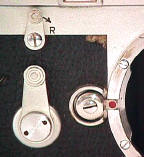
Unlike later M's, the M3 has a lens release button with a guard around it. Likewise the M3/M2 have metal self timers, which would become plastic tipped by the M4. The frameline preview lever is missing from earlier M3's, though it could be added later. The missing vulcanite body covering on this worn M3 can be repaired, but new vulcanite coverings are no longer available from Leica.

The M3 back door and removable baseplate is basically the same design as used on all later M's, though the M5 was slightly different with its rewind lever built into the baseplate.
Per Laney's Collector's Guide, significant M3 changes occurred at:
700,000 Starting Point (1953
785,801 (1955) added Viewfinder Frame Selector Lever (very convenient)
844,001 (1957) glass film pressure plate changed to metal
919,251 (1958) Lever advance changed from two to single stroke. In use "single strokes" are generally much preferred, but some old timers are adamant that the "double strokes" are smoother and even last longer because each stroke puts less stress on the gearing.
919,251 (1958) Depth of field indicators placed in the Rangefinder. Notice the little cutouts on the upper and lower edges of the RF image. The cutouts indicate Depth of Field for 50mm lenses at f/5.6(larger lower cutout) and f/16(larger upper cutout). If the double rangefinder image is within the cutout, either in front of or behind the focused object, both objects will be sharp.
M3's with serial numbers over 1,000,000 have a premium placed on them, providing they are in collectible Mint- or better condition. Many people believe, rightly or wrongly, that these cameras are the highpoint of Leitz craftsmanship. It was the end of production with a very experienced work crew of craftsman. The serial #'s over 1.1 million are even more highly regarded, for the exact same reasons. Most of the very last M3's (aprox 1,000) had the later and in some people's mind less desirable M2 type lens release. Whether the later M3's really are better made by a small amount is not that important in practical terms, that they sell for more is.
Later M3's probably have a more dependable shutter than earlier ones, although I do not know the serial # cut off. In any case, my own favorite is the later M3's with all the features over serial # 919,251. NOTE that earlier cameras could be converted to later features by Leitz or authorized repair stations.
If you like to shoot the 50/1 Noctilux or the 75/1.4 Summilux, M3's focus them more accurately than any other M with the longest effective rangefinder base length and focusing accuracy in the M series. M3's can focus 25% MORE ACCURATELY than the M4/M5/M4-2/M4-P and M6 due to longer effective baselength rangefinder. See my Profile on Rangefinder Viewfinders. If your main lenses are the 50 or longer, the M3 has the largest and therefore the best viewfinder for you.
M3 Bargains: Ugly, dented, well used, or Social Security engraved M3's often sell in the $500-700 range even if they are the late Single Stroke type. As long as the body works properly, these M's can make very attractive shooters from a dollars to performance standpoint. The best user M3's are the late ones with single instead of double stroke film advance, a frame preview lever, and depth of field indicators built into the finder. Made primarily in chrome, black paint M3's are very rare.
Mint or near Mint M3's are better off kept on the shelf as a collectible. A few dings, dents or scratches will lower its value 30-50%.
M3 Lens Choices: An interesting strategy is to have the 3 lenses the M3 is framed for (50,90,135), and then skip to the super wides, your choices of the 12, 15, 21, 24/25. Do you really need a 28 or 35 with your M3? Maybe, maybe not, depending upon what you shoot.
M3/M2/M1 Upgrades
Remember the youngest M3, M2, M1 is over 40 years old now. If you use it regularly, spend the bucks to have it overhauled, cleaned, lubricated, adjusted.
The M3, M2, M1 share a weird sync post that are NOT compatible with the standard PC cord. Use an adapter and you can use the standard PC cord. You can also have your repairman install a standard PC outlet.
The M3, M2, M1 left the factory with a slow film loading system. You can improve it with the now discontinued Leica Quickload kit, making your film loading much quicker and easier. Even after the Quickload kit, they are much slower to load than the M4 and later cameras. The M3 is slower to load than the M2 because you must remove the film spool to reset the film counter, the M2 has a manually set film counter. Another option is installing the easier M4 type loading, but the conversion is not cheap.
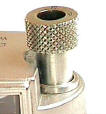
The M3, M2, M1 share a slow film rewind knob. There are a number of after market lever rewind attachments which can improve on this. The new Leica MP 2003 rewind lever attachment is very well made, the most expensive, but unfortunately not well designed. 2011 saw the introduction of the CameraQuest M2/M3 film lever rewind crank V2. Modestly I can say I think it's the best one out there.
Finders: Some dedicated Leica nuts are just sure their Leica will be better if it has another finder in it. Upgrading the M2 finder to the .72 M6 finder is easy. I have also heard of some people paying the extra dough to have a M4 finder in the M3. It can be done, but it's a custom job and expensive. Likewise a M3 can be put in a M4 if you are willing to pay the bill, but this makes little sense today with the .85 M6 being easily available.
The small Voigtlander /35 MiniFinder is ideal for the M3, giving the M3 28 and 35 brightlines in the smallest, lightest possible package.
Scratched Glasses: The M3, M2, M1 finders have a metal eyepiece which is hell on glasses. Cure the problem with tape or a rubberized cutout, or M donuts.
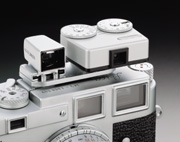
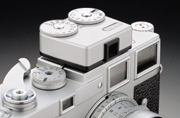 The M3, M2, M1 do not have a built in meter,
and short of Bill Gate's money, are not likely to. Remember the add on
Leica MR-4 CDS meter does an excellent job while increasing your M's size a minimum
amount. Be very careful about mounting the meter. I have seen hundreds
of M's with scratched top plates from the various MR meters -- costing the camera
owner's hundreds of dollars or more in lower resale value. Before even trying to
mount the meter, it would be a good idea to use a tough vinyl tape on the underneath side
to make sure you can't f-- up. I remember one mint M2.
The owner couldn't remember how to take off the meter. He not only scratched the
top plate removing it, he actually BENT the top plate too. Unfortunately I
witnessed the event. It made me sick. I had to shoot Nikons for a week to get
over it. The best solution is the
Voigtlander VC Meter II. The VC II is to my mind far and away the best
meter ever for meterless Leica rangefinders, of any vintage.
The M3, M2, M1 do not have a built in meter,
and short of Bill Gate's money, are not likely to. Remember the add on
Leica MR-4 CDS meter does an excellent job while increasing your M's size a minimum
amount. Be very careful about mounting the meter. I have seen hundreds
of M's with scratched top plates from the various MR meters -- costing the camera
owner's hundreds of dollars or more in lower resale value. Before even trying to
mount the meter, it would be a good idea to use a tough vinyl tape on the underneath side
to make sure you can't f-- up. I remember one mint M2.
The owner couldn't remember how to take off the meter. He not only scratched the
top plate removing it, he actually BENT the top plate too. Unfortunately I
witnessed the event. It made me sick. I had to shoot Nikons for a week to get
over it. The best solution is the
Voigtlander VC Meter II. The VC II is to my mind far and away the best
meter ever for meterless Leica rangefinders, of any vintage.
Rapidwinders: Tom Abrahamsson of Rapidwinder.com produced a small number of limited edition M2 trigger winder Rapidwinders. They are difficult to find, but well worth looking for -- much less expensive as well as more reliable than the original MP Leicavit. The M3 uses a different advance system, though if you are willing to throw enough money at it, I have seen a M3 adapted by an independent repair man to take the MP Leicavit or Rapidwinder. Likewise, if you are fanatic enough and can find the repairman who will tolerate your fantasies, either can be adapted to the M6 winder if your pockets are deep enough.
The Voigtlander deluxe camera strap works quite well on most any classic camera, at a bargain price.
M2 1958-1967

The M2 is a modified single stroke M3. With its .72 finder magnification instead of the M3's .91 magnification, the M2 can show the wider 35mm frameline with the 50 and 90 frames -- though the 135 frame is missing on the M2. Unlike the M3's automatic film counter, the M3 has a manual film counter rotating around the shutter release. M2's have the frameline preview lever. At a quick glance, the M3 and M2 can easily be mistaken for each other. Shown mounted is the M2's most popular contemporary lens, the chrome 35/2 Summicron.
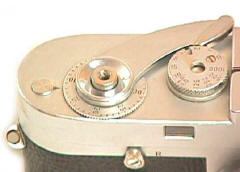

Notice the M2's manual set film counter rotating around the shutter release. This one has as rewind lever, earlier ones had a button. Starting with the M2, the frameline illumination window had fresnel cover to it to gather more light. Unlike the M3, the M2 has no raised borders around the viewfinder windows.
M2's have a Depth of Field indicators built into the RF cutout. Notice the little cutouts on the upper and lower edges of the RF image. The cutouts indicate Depth of Field for 50mm lenses at f/5.6(larger lower cutout) and f/16(larger upper cutout). If the double image is within the cutout, either in front of or behind the focused object, both objects will be sharp. Unfortunately, this feature was not continued with later M's.
Like the M3, shutter speeds are 1 to 1/1000th plus B. Intermediate speeds can be set from 1 to 1/8th, 1/15th to 1/30th, and 1/60th to 1/1000th. The red lighting symbol on the shutter dial indicates 1/50th flash sync for electronic flash.
Though promoted at the time as the M3's less expensive little brother, the M2 has an elegance all its own. I find myself preferring its simple non cluttered 35/50/90 finder over the jumbled feeling I get looking through the M6. Comments about the M3's sync posts and loading also apply to the M2. The M2 and M3 were Leica's last ALL METAL cameras. Made primarily in chrome, black M2's are rare.
The M2 and M3 lack hot shoes and affordable motors, if that is your need. The M2/M4/M4-2/M5 finders can be updated to the 28/35/50/75/90/135 finder system of the M6 as a standard Leica upgrade.

The M3, M2, M1 share a slow film rewind knob. There are a number of after market lever rewind attachments which can improve on this. The new Leica MP 2003 rewind lever attachment is very well made, the most expensive, but unfortunately not well designed. 2011 saw the introduction of the CameraQuest M2/M3 film lever rewind crank V2. Modestly I can say I think it's the best one out there.
M4 1967-1975
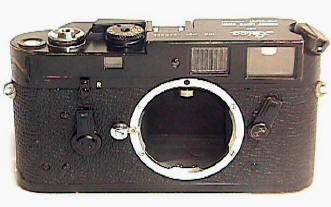
A lot of people, myself included, consider the M4 to be the last classic standard production M. The M4 generally maintains the finish and feel of the M3/M2's craftsmanship while still having significant new improvements: finder brightlines for 35/50/90/135 lenses, much faster film loading, much faster rewinding with a new rewind lever, and a self resetting film counter which resets every time you remove the bottom plate. The M4 finder was basically a M2 finder, with the 135 paired with 35 frame. The M4 has ALWAYS BEEN one of the best and most popular M's. Only 58,000 M4's were made, compared to 225,000 M3's and 83,000 M2's. This helps keep the M4 prices up. While made primarily in chrome, both black paint and black chrome versions were produced. The M4 became the basis of the later M4-2, M4-P, M6, M6 .85, and M6 TTL. The M4 finder can be changed to the later 28/35/50/75/90/135 finder system of the M6 as a standard Leica upgrade. Personally, I prefer the M4 finder as it is, less cluttered. If you love your M4, about the only change to it I would recommend is to add a hot shoe next time you give it a CLA (clean, lubricate, adjust).

It seems like a small thing to any sane person, but in Leica terms, the transition from the M3/M2's slow knob rewind to the M4's quick rewind was a biggy.
.
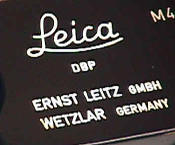
Take a good look at the engraved top plate of the M4, a luxury sadly missing from standard production M's until the MP 2003. What's the use of buying an expensive camera if it doesn't have an expensive look about it? Don't under estimate the value of Leica as jewelry to the well heeled photog.
Unfortunately later black M4's had the black chrome finish of the concurrently produced M5, instead of the earlier black enamel finish. Black Enamel VS Black Chrome is a game collectors like to play. There is little doubt the enamel is much more beautiful when new. Each finish shows wear very differently. I prefer the brassing of the black enamel to the discoloration of the black chrome -- but it's in the eye of the beholder. I believe Leica would have at least a short term best seller on its hands if black enamel were re-introduced on the M6.
The best meter for the M4 is the Voigtlander VC Meter II. The VC II is to my mind far and away the best meter ever for meterless Leica rangefinders, of any vintage.
M5 1971-1975 Orphan Leica
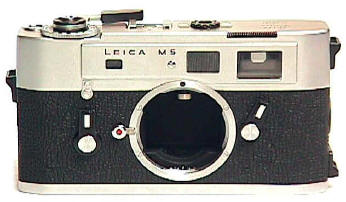
The M5 was Leica's first TTL (thru the lens metering) body. The M5 is also noticeably larger than the other M's. Some love the M5's larger size, some hate it. See Separate Profile. The M5's innovative design was a Leica dead end with a short production life. I call it an "orphan Leica." While it size may take some getting used to, it does have some nice features which include:
Shutter speeds visible in the finder
A very large and convenient shutter speed dial. The shutter speed dial over hangs the top plate, so it can easily be turned by the right index finder while selecting the shutter speed in the finder.
Large RATCHETED film rewind on the baseplate
Vertical as well as horizontal straps--I much prefer the vertical. I think it's a mistake the M6 doesn't have this type of strap lugs.
A smaller more precise metering area than the M6 thanks to the metering cell in front of the shutter curtain, which snapped down just before the exposure.
The M5 was the last hand assembled Leica, made the "old fashioned" way.
Alas, poor M5 sales almost killed the M system, literally. That's right, M5 sales were so bad that Leitz decided to end M production and bet its future on the R system (not a good idea sales wise). Only persistent efforts of M lovers managed to get M production going again in Canada at Leitz Midland.
The M5 has been discovered by collectors. Clean examples command high prices. This is very ironic since it was no sales success. New M5's sat unclaimed on dealer's shelves years after they were discontinued. The great majority of M5's are black chrome finish. Black chromium was introduced on the M5. Unfortunately black chrome cameras have a tendency to look down right UGLY with a lot of wear, unlike black paint cameras that tend to have "personality" with the same amount of wear. Chrome was also a standard finish option. The rarest production M5 is the Leica 50th Anniversary model. I suspect a M5 stripped repainted black or grey hammertone would look marvelous.
Well used M5 bodies, however, can be bargain priced satisfying users. The M5 was made for the outlawed in the US mercury 625 battery. If you can't get them, the M5 can be adjusted to the alkaline battery replacement. The easiest solution is to buy them out of the country where they are still easily available.
The M2/M4/M4-2/M5 finders can be updated to the 28/35/50/75/90/135 finder system of the M6 as a standard Leica upgrade.
1973-1976 Orphan Leica
If you want a lightweight carry all day sophisticated camera with great lenses and TTL metering, it's difficult to make a better choice than the CL.
Sometimes disparaged because of its made in Japan heritage, the CL occupies a unique and important spot in the Leica M world. Introduced in 1973 and discontinued only three years later, the Minolta made Leica CL is Leica's smallest and lightest interchangeable rangefinder ever. So far, it is also the only Leica M camera made by another manufacturer. The CL's innovative design was a Leica dead end with a short production life. I call it an"orphan Leica."

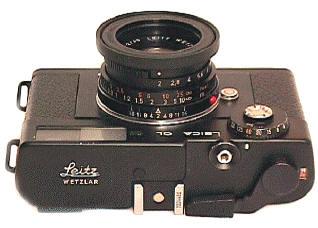
In one package the CL is 1) the smallest Leica rangefinder camera 2) the smallest M mount camera and 3) the smallest TTL metering interchangeable lens rangefinder camera. See details in Profile Real world, they have a reputation as charming cameras, but not as reliable as their Leica M big brothers.
M4-2 1978-1980: The Plain Jane Camera that SAVED Leica
The M4-2 deserves credit for something not generally acknowledged: fame as the camera that saved Leica. With poor M5 sales, the decision was made to stop making M's and concentrate on the R series. With 2020 hindsight that decision would most likely have killed Leica, as R sales were always less than anticipated. Luckily, Walter Kluck, the CEO of Leitz Canada managed to convince Leitz Germany to produce a new lower cost to manufacture M4, called the M4-2. This was a critical event for the Leica M, and for the Leica camera company. Without his intervention, the M camera would have likely died with the shut down of the M5 production line. Leitz management wrongly believed the future of the camera company was the Leica R system. HA HA HA. Unfortunately all Leica SLRs have always been outdated body designs from their day of introduction, albeit with great lenses, and very poor sales. The M line stayed in production to become Leica's best selling interchangeable lens camera. Even more fascinating is that the stuffy Leica management to this day don't officially acknowledge that the M4-2 is the camera that saved Leica -- talk about living in denial!
The M4-2 was a simplified, cheapened M4, without the famous Leica script top plate engraving and the traditional vulcanite body covering. The M4-2 was the first of the Plain Jane Leicas.
Real world, the M4-2 amounts to a cheapened M4 with a hot shoe and out of the box motor capability added. With production moving to Midland Canada, many believe the M4-2 initially suffered teething problems and quality control compared to either its M ancestors or M descendents, yet many owners report they are quite happy with their M4-2.
The bad part of the M4-2 (and the standard production M's that followed), is the noticeably lower quality of exterior finish compared to the M's that went before it. It's the story of the plain sister who could never quite compare to her older beautiful sister. The wonderful Leitz engraved script on M2/M3/M4 top plates was replaced by cheaper stampings. The vulcanite was replaced by a cheaper plastic material which in my experience does not wear as well. The old chrome finish is replaced by what seems be a thinner finish with less luster. The magnificent old black enamel was replaced by less expensive black chrome (which looks very ugly when it wears). The great majority of M4-2's are black chrome, they were unfortunately not produced in black paint. Chrome examples are rare and expensive. There was also a gold M4-2 commemorating Oskar Barnack, the inventor of the Leica camera. The most desirable M4-2's were made in Wetzlar at the start of M4-2 production, numbering only 100 or so. While a half frame M4-2 was planned, only a hand full were actually produced before the project was dropped. Fake half frame M4-2's probably outnumber the real ones about 1000 to one.
Now to be fair about it, all camera manufacturers offer cheaper products now compared to the 1960's. It's just that Leica has always been held to a higher standard than the rest by virtue of its higher prices. To Leica's great credit, Leica found a way to adapt and survive -- something that the great German made cameras by Zeiss, Voigtlander, and Rollei did not discover in those changing times. Some claim that the interior of the cameras were improved as they time went on to make more dependable cameras. Perhaps, perhaps not. In thirty years, we might have some definitive answers, but not now.
The M4-2 finder can be updated to the 28/35/50/75/90/135 finder system of the M4-P or M6 as a standard Leica upgrade. All later M motors are backwardly compatible to the earlier M4-2.
The best meter for the M4-2 is the Voigtlander VC Meter II. The VC II is to my mind far and away the best meter ever for meterless Leica rangefinders, of any vintage.
Mr. Horst Braun, Manager of Leica Repairs, has confirmed a modification of the M4-2 finder about half way into production. As I understand it, a small condenser lens was removed from the frameline masks which had the effect of increasing the brilliance of the finder image and its frames. Unfortunately, it is not possible to retrofit this into later M's.
Apparently this was done to improve Leica's profit margin. Well, I guess it worked...Leica is still around today. However, the downside is that the new improved rangefinder sometimes has ghosts or flare which makes focusing difficult. I have reports that sometimes one of the RF images are difficult to see. Others opine the newer RF image is definitely not as bright as the earlier M3/M2/M4 finder -- though frankly the brightness difference is hard for me to see.
An easier to see difference is that the new finder requires the photog's eye to be centered in the viewfinder to easily see the RF image. Off center, the RF image can disappear. The older finder had more tolerance for the off-center photog.
Guess what? This new finder made its way to the M4-P and continues today in the M6. Personally I very seldom encountered the ghosting problem, but enough people have emailed me about it, so that I have no doubt it can be bothersome in some lighting conditions. Picky picky picky. I guess Leica didn't know the trouble it would get itself in by establishing such a high standard in the 1950's and 60's. Apparently more modifications were made in the M6 to fit the LEDs in. The M with the worst reputation for patch flare out is the M6 .85 TTL. The M7 improved the problem somewhat with better finder coatings. The MP 2003 finally introduced a finder up to the old standards by adding another condenser to the finder design, a change which was also made to the M7. If you are a newbie and this is new info, you need to understand that we are splitting hairs here. Any Leica M finder in good working condition is a great picture taking machine.
Internal Construction: M4-2 and later cameras Vs M3/M2/M4
Remember that M4-2 production commenced in Canada AFTER Leitz Germany had originally decided to end M production, and while Leitz was still in deep financial woes. It was time to cut costs, make profits, and find a way to survive. This was no small achievement that Zeiss, Voigtlander, and Rollei German made cameras could not accomplish.
Starting with the M4-2, Leitz changed the
M camera design philosophy and internal construction. Originally, the
M's were all designed to be adjusted to the Nth degree in order to attain the highest
standards.
With the M4-2, Leitz started shifting to a "right or replace" construction
philosophy. Adjustments starting
disappearing. The new way was to simply replace out of tolerance part with a new one which
was within tolerance.
The claim is this makes for a stronger, more reliable camera since adjustments can no
longer go out of
whack. But of course, they neglect to mention the overwhelming consideration here is
lowering cost!
The "old construction" proponents like myself argue that individual
adjustments produce overall tighter tolerances and a better working camera.
Which is better? Each camp argues they are right. Perhaps in 30 years, we will be sure.
Of course Leica "experts" with close factory connections were usually the ones
arguing the loudest that the new cameras were not only as good, but better than
the older designs using different construction criteria.
Alas, their spurious arguments left a lot of egg on their
face when the new Leica MP was introduced in 2003. After all, how could
the new MP be an improvement, if the intervening mechanical standards starting
with the M4-2, were not a bit lacking? The emperor has no clothes.
Minolta CLE: 1st M with AE or TTL Flash 1980-85
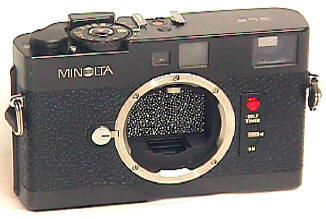
OK, it's not a Leica, but it is a wonderful Leica M mount camera.
The Minolta CLE was introduced 1980--almost twenty years ago. Yet, father Leitz makes haste very slowly. For 22 years, until the introduction of the Leica M7, the CLE remained the most technologically advanced M camera ever produced. Most CLE owners consider it one of the best cameras they have ever owned. It has a delightful finder, and unlike some M's has a usable 28 frameline for glasses wearers. The CLE's biggest design flaws were 1) no metering on manual exposure and 2) no AE exposure lock. Today the CLE's biggest problem is lack of replacement parts. A dead circuit board means you have a very nice paperweight.
Compact like the older CL, the CLE (electronic) boasts a list of impressive new features. Instead of the 40/90 combo for the CL, the CLE uses a more useful set of 28/2.8, 40/2 and 90/4 multi coated Rokkors. They use Leica's traditional parallel focusing cams for complete focusing compatibility with the rest of the M system. The CLE rangefinder is longer and with a brighter RF focusing spot than the CL. The CLE was the 1st M mount camera with TTL flash as well as AE aperture priority. Until the M7 in 2002, the CLE was the ONLY M mount camera to offer both TTL flash and AE. See the details in the CLE profile.
M4-P 1981-1987 Plain Jane M with Deluxe Variations
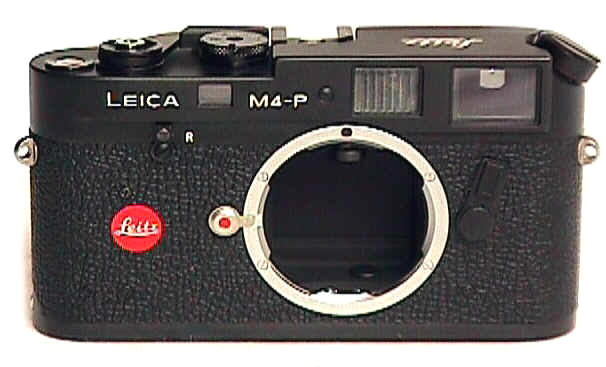 The M4-P adds to the M4-2 features by adding a six position finder for
28/35/50/75/90/135 lenses by pairing the 35 & 135 frames, the 50 & 75
frames, and the 90 & 28 frames. Unfortunately the new finder layout
is rather cluttered visually and the 28 frame can't easily be seen by people wearing
glasses. If you are a Nikon Rangefinder fan, note that Leica took only 23 years to equal
the Nikon SP's six built in framelines. Leica makes haste slowly.
The M4-P's .72 magnification six brightline finder remains the standard Leica
M6 finder to this day.
The M4-P adds to the M4-2 features by adding a six position finder for
28/35/50/75/90/135 lenses by pairing the 35 & 135 frames, the 50 & 75
frames, and the 90 & 28 frames. Unfortunately the new finder layout
is rather cluttered visually and the 28 frame can't easily be seen by people wearing
glasses. If you are a Nikon Rangefinder fan, note that Leica took only 23 years to equal
the Nikon SP's six built in framelines. Leica makes haste slowly.
The M4-P's .72 magnification six brightline finder remains the standard Leica
M6 finder to this day.
Some veteran Leica lovers believe the M4-P to be made to a generally higher standard than the M4-2 before it, others argue the point. The great majority of M4-P's are black chrome, they were not made in black paint. Chrome was a standard finish, but was much less popular than the black chrome. Also produced were 200 M4-P Mt. Everest Expedition commemoratives and 2500 silver chrome 70th anniversary M4-P's commemorating the 1913 Ur-Leica. A few M4-P's, along with selected lenses, were specially engraved for the use by the Press at the 84 Los Angeles Olympics. Very late M4-P's have M6 style top plates. Many sources say all M4-P's were produced in Canada, with M production moving back to German with the M6. It turns out the last 1000 M4-P's were actually assembled at Wetzlar, after M6 production had started. Serial numbers 1691951 to 1692950. Eventually Leica closed the Midland Canada plant, selling Elcan (E Leitz Canada) to Hughes Aircraft (founded by Howard Hughes) in 1990. Hughes completed the sale of Elcan to Raytheon by 1999. Today Elcan still exists, see Elcan.com. While primarily a military contractor, Elcan produced some Leica optical lenses such as the 75/1.4 and 50/1. The last Elcan Leica lens was the 50/1, which was discontinued in 2007. This forced Leica to discontinue the 50/1 Noctilux in 2008. Leicanuts often ignore the importance the Midland plant, but without Midland and its M4-2 and M4-P, it is very doubtful if the Leica M system would still be manufactured today.
The best meter for the M4-P is the Voigtlander VC Meter II. The VC II is to my mind far and away the best meter ever for meterless Leica rangefinders, of any vintage.
M6 "Classic" 1984-1998 Plain Jane M with Deluxe Variations
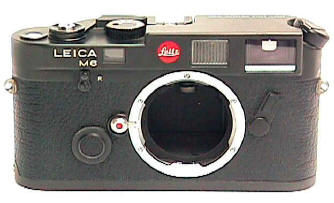 The M6's claim to fame is its
convenient accurate silicon TTL LED readout metering, while maintaining the classic M
shape. Imagine the M4-P with TTL metering, that's the M6.
Experienced users often believe the M4-2/M4-P/M6 do not have the smooth film advance of
the earlier M3/M2/M4. This is explained away with the use of steel gears rather than brass
due to the motor capability. While I might complain a bit when it's compared to its
predecessors, there is no doubt the M6 is still a
great camera in its own right. The M6 was introduced in 1984. From 1984
to 1998, everyone called it the M6. Most people still call it the
M6. After introduction of the M6 TTL, many began to call the
original M6 the "M6 Classic," though I have found no official use of this
term by Leica. The M6 also marked the return of M production to Wetzlar Germany from
Midland Canada, even if production soon moved to the new factory in nearby Solms.
The M6 classic was a long lived high production camera with many small
variations and special editions.
The M6's claim to fame is its
convenient accurate silicon TTL LED readout metering, while maintaining the classic M
shape. Imagine the M4-P with TTL metering, that's the M6.
Experienced users often believe the M4-2/M4-P/M6 do not have the smooth film advance of
the earlier M3/M2/M4. This is explained away with the use of steel gears rather than brass
due to the motor capability. While I might complain a bit when it's compared to its
predecessors, there is no doubt the M6 is still a
great camera in its own right. The M6 was introduced in 1984. From 1984
to 1998, everyone called it the M6. Most people still call it the
M6. After introduction of the M6 TTL, many began to call the
original M6 the "M6 Classic," though I have found no official use of this
term by Leica. The M6 also marked the return of M production to Wetzlar Germany from
Midland Canada, even if production soon moved to the new factory in nearby Solms.
The M6 classic was a long lived high production camera with many small
variations and special editions.
Used M6 classics are great choices as Leica shooters, often selling for less than half the price of a new M7 or MP 2003. We are seeing the lowest used prices for classic M6's ever.
M6's have been cursed by some ridiculous commemoratives under the guise of making an instant collectible to get the maximum bucks. The one which gets my loudest laughs is the "Royal Danish Wedding" M6. Who can imagine what Solm's marketing geniuses will try to make a buck on, err....commemorate next? I hoped a "Royal Charles and Diana Divorce" Leica would be sure to follow, alas not yet. I like many of Leica's special edition cameras, but when they commemorate not so important events, it makes me wonder.
Bucking this trend is the worthwhile but very expensive M6J, a M6 made to the higher standards of the M3, with a beautiful chrome finish and engraved top. Besides the $9000 price tag, perhaps its most noteworthy feature is the finder. Magnification is increased to .85, therefore also increasing focusing accuracy. See profile on Leica Finders. Framelines are 35, 50, 90 and 135 only. If you can afford it, the M6J is a special edition well worth having.
About 1996/97 plastic parts replaced metal parts in the frame counter, resulting in increased breakdowns. Unfortunately, Leica has not revealed the exact point of these changes. Apparently the problem has since been corrected.
M6 Battery Life: B turns the battery circuit off, but it is not so marked on the shutter speed dial. If your M6 classic does not have the shutter advanced, the meter will not go on--and so there can be no battery drain. If your M6 shutter is advanced, the LEDs will go on for a few seconds when the shutter release is slightly depressed EXCEPT if the shutter speed is "B." IF you store your M6 in your camera bag WITH shutter advanced, turn the shutter speed dial to B. This will avoid anything depressing your shutter and draining the batteries. In the long run, this is much cheaper than sending your depressed shutter to counseling and also avoids the expense of valium. Sorry, I couldn't resist that bad camera joke, Nikon made me do it. The M6 TTL cured the problem with an off switch on the shutter dial.
A weak point of the M6, M6 TTL, M7 and MP is the battery compartment design. The battery cap is a weird design on the front of the camera, where the self timer is located on many cameras. The screw in cap is awkward to remove or install. You would think that Leica could have found a better solution, but it hasn't happened so far.
Black or Chrome or Titanium? Long term, a worn black chrome looks downright ugly, although black may be easier to shoot without being noticed -- maybe. The chrome has a nice "retro" look about it which I like more than the black. Overall, I personally prefer the Titanium, which has the most rugged and scratch resistant finish. Unfortunately the M6 Titanium was produced with a rather odd artificial ostrich body covering which does not go well with the top plate -- at least in my opinion. Titanium M6 classic production stopped with the introduction of the M6 TTL. The Titanium M6 and its matching Titanium lenses are rather low production, and sure to be future collectibles. Yes, before you ask, the M6 classic finishes are limited to black chrome, silver chrome, and titanium. My personal favorite is the titanium M6. Too bad the M6 classic was not made in black paint.
Although the M6 & M4P have built in framelines for the 28, the eye relief makes them useless for people who wear glasses. So far the only M mount cameras with a visible 28 frameline for glasses' wearers are the Minolta CLE, Konica Hexar RF, and Leica M6 .58 TTL and M7 .58 TTL. Of these, the Leica .58 finder and Minolta CLE finder are far superior to eye glass wearers in side by side comparisons.
New "M6 .85" February 1998
Leica announced a new "M6 .85" with a .85 higher magnification finder in February 1998, in black chrome only. The higher magnification .85 finder with the 35/50/75/90/135 frames--means NO 28 frameline. It's identifiable by an etching of ".85" on the lower mirrored front of the M6 finder. Although VERY similar to the M6J's viewfinder, the .85 is different in having an added 75 frame, and in having a slightly higher image magnification.
The .85 finder is a good decision on Leica's part, since it complements the existing M6 very well. Unfortunately it developed a reputation for having more than its share of flare compared to the .72 finder. Perhaps the most amazing thing is that a lot of people asked for this after the intro of the M6J and Leica actually listened. See VF/RF in Profiles.
Should you buy the .85 M6 over the old one? Yes if 1) you shoot the 50/1 or 75/1.4 and therefore need the added 25% focusing accuracy 2) you don't like/need the 28 frameline--you probably can't see it anyway if you wear glasses 3) You want larger framelines for the 50 to 135.
ALAS, there are flies in the soup. Leica went a little bit too far in increasing the magnification with the .85. It is virtually impossible to see the ENTIRE 35 frameline AT ONE TIME, even if you don't wear glasses. Unfortunately if you wear glasses, you have a better chance of finding an honest politician than you have of seeing the .85 M6's 35 frameline. In this respect, the finder in the rare M6J is superior. Worse, users report that the .85 finder is the most flare prone of the three Leica M 6/7 finders: .58, .72, and .85.
The original .85 M6 (produced only in black) was replaced about six months later with the introduction of the .85 M6 TTL. Total production per Leica only 3,130 cameras. This translates to a future collectible, but only unused boxed cameras are likely to have much appreciation value over the next few years. How much? No one knows.
M6 TTL 1998-2002
Orphan Leica: Plain Jane M with Wrong Way Shutter Dial and Deluxe Variations
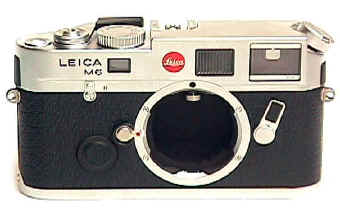
Announced at Photokina in September 1998, the M6 TTL's was a Leica dead end design with a short production life. I call it an "orphan Leica."
Changes include TTL flash (a 1st for a Leica M body), a 3 LED meter readout instead of the previous 2 LED readout, a larger and easier to turn shutter speed dial with OFF position, which unfortunately rotates the OPPOSITE way from all previous Leica M's. These internal changes required a body which is 2mm higher.
A quick way to recognize the M6 TTL from the M6 classic is the MUCH larger shutter speed dial. In practical terms the new larger shutter speed dial is easier and faster to change speeds. This allows the TTL shutter dial movement to correspond to direction of the plus or minus finder LEDs, which in turn correspond to the direction of the lens f/stops. Unfortunately the TTL shutter speed dial rotates in the opposite direction of earlier M's, which many experienced M users find quite distracting. This backward in traditional terms shutter speed dial rotation was continued with the M7, but dropped in the traditional and very popular MP 2000, thus creating the orphan status. The "wrong way" shutter dial makes the M6TTL the best manual M to complement the "wrong way" M7 -- or the M7 the best AE camera to complement the M6 TTL.
As introduced, the .72 M6 TTL was available in both black and chrome, while the .85 M6 TTL was available in black only. By September 1999, the decision was made to add a chrome .85 M6 TTL to the lineup. Over time various special edition M6 TTL models debuted, as well as the .58 TTL.
Be sure to carry extra batteries. The M6 TTL has the reputation of much heavier and quicker battery drain than the M6 "classic." The M6 TTL was discontinued in 2002, amid the popularity of the M7, and heavy M6 TTL rebates to bargain hunters. Also announced with the M6 TTL were the new 90/2 APO ASPH and 135/3.4 APO. It's great to see Leica making a substantial effort in improving the M line.
Unfortunately the M6 TTL just offers very basic mid 1970's style center weighted off the film plane flash. BIG DEAL! You will find no modern multi-segment matrix flash metering or multi TTL flash capability here. Personally I am not too impressed with the limited Leica SF20 flash, which does not even have a rotating head for bounce flash. While the SF20 lithium batteries are said to last a very long time, there is little doubt lithiums will also be hard to find in many locals. Other AA powered flashes with bounce flash capability such as Metz and Sunpak, are better choices for your TTL as far as I am concerned. The TTL flash circuit oddly run off the camera's battery. This prevents the flash from being used at higher than the 1/50th flash sync speed -- something that is possible with non-TTL M's which can result in no pics if your shutter is inadvertently set at too high a speed to sync with your flash. Unfortunately, the M6 TTL flash circuit also means if your battery is dead, your flash is effectively dead too. I also have reports that some old flashes may not work with the TTL flash circuit, but I don't see why you would buy a M6 TTL and then not use a modern TTL flash.
.58, .72, or .85 Finder? The M6TTL was the first M body to be offered in your choice of three different finder magnifications: .58, .72, or .85 (identifiable by the .58, .72 or .85 on the lower front right of the front viewfinder window). Alas, choices are not always simple, this is one of those times. The .72 magnification finder was the standard M finder for many years, and the only M finder since the introduction of the M4 in 1967. The .72 is the standard by which all other M rangefinder finders are judged.
Listening to users, Leica introduced the higher magnification .85 finder in 1998 for increased focusing accuracy with fast lenses like the 50/1.1 and 75/1.4. Sacrificed was the 28mm frameline. Going in the other direction, the wide angle .58 finder was introduced in 2000, sacrificing the 135 frameline. In practice the .85 finders proved to be more flare prone than their lower magnification counterparts, while most 28 and 35 lovers just fell in love with the .58 finder for its clarity and easy to see even with glasses 28 and 35 framelines. How to tell which finder magnification is which? The finder magnification is etched in the bottom right front of the M6 TTL finder -- .58, .72, or .85. The .58 finder has only been used in the M6TTL, M7, and MP 2003. The .85 finder has only been used in the very late M6 "classic," the M6 TTL, M7, and MP 2003. A good repairman can probably install either the .58 or .85 in any M.
Finder choices got complicated in 2002 with the introduction of the 1.25x M Eyepiece Magnifier which turns the .58 into a .72, the .72 into a .9, and the .85 into a 1.06. Damn. If you are going with only one M body, a good case can be made that you only need a .58 with a 1.25x Eyepiece Magnifier, or a .72 with a 1.25x Eyepiece Magnifier.
Black or Silver Chrome? Side by side, the current Leica silver chrome does not match the chrome on the M4 and earlier cameras, but is it still nicely done. Even so, I greatly prefer the silver chrome finish to the black chrome finish, because the silver chrome wears much better over time. With age and wear, the black chrome M finish takes on a tattered ugly look - at least as far as I am concerned. Look at a well used black chrome M4-2 or later M to see what I mean. Better by far than the standard black chrome or silver chrome finishes in my opinion is black paint.
Millennium Black Paint M6 TTL Based on the .72 TTL M6, the Millennium has the traditional Leica engraved script top plate (like the M3/M2/M4), black paint finish, and a M3 style rewind knob. For a traditional Leica nut like me, this retro black paint finish with the traditional Leica script was wonderful news indeed. 2000 cameras were made for the Year 2000. Of course, malcontents like myself will complain that the Millennium does not start until the year 2001. Indeed this camera quickly sold out, and is now fetching high premiums over the initial price. See Profile The Millennium camera marked an important turning point at Leica, where the bean counters started listening to what serious Leica users had been wanting for decades: the return of the black paint camera and Leica script engraving. Once the bean counter anti photographers realized sales go up when you give customers what they want, black paint and script engraving would be offered on the later M7 and MP 2003.
Millennium Green Paint M6 TTL: The Hong Kong Leica importer ordered what amounts to 300 Green Paint Millenniums with a .85 finder, though they are not called Millennium cameras. It is just like the black paint version, only a better quality green paint with chrome top plate fittings. To me, this is one of the prettiest Leicas. See PICS and Profile
LHSA Black Paint M6 TTL This is the Special Edition Black Paint M6 made for the Leica Historical Society of America. It is the 2nd black paint M6 TTL, though planning on this one actually started before the Millennium. I find it a better shooter than the Millennium because the LHSA has the M6 type rewind. Orders were stopped June 30, 2000. It is now heading for collector status. Personally I think it is the prettiest of ALL the various black paint M6. It is the only M6 TTL with a factory BLACK "red" dot. See Profile Initially only .72 and .85 magnifications were offered. In 2002 60 .58 LHSA cameras were produced. 2003 saw the continuation of the LHSA series with the introduction of a grey hammertone LHSA MP set, complete with body, 35/2, and MP Leicavit.
M6 TTL .58 for Photokina Sept 2000: Leica introduced a new version of its M6 TTL body with the lower magnification .58 finder with 28, 35, 50, 75, 90 framelines. It's for eyeglass wearers who can not see the edges of the wide angle framelines with the .72 finder. Unfortunately, nothing more substantial in Leica M body improvements was introduced at Photokina 2000, though the new compact M motor and 28/2 M Aspherical look like real winners. This Leica equivalent of Nikon's "High Eyepoint" finder for glasses wearers only come out 47 years after the M3's introduction, and only one year after the Konica Hexar RF's introduction with its practically identical .6 finder with one more frameline.
M6 TTL Titanium November 2001. Leica re-introduced the tough Titanium finish for 1000 new limited edition Titanium .72 M6 TTL cameras. Thankfully the new Titanium cameras will not have the Emu simulated body covering of the previous Titanium M6. Happily the simulated red Buffalo leather pattern be more aesthetic than its big bird ancestor, but I still don't think Leica has got it right. When is Solms going to finally introduce the Titanium with a STANDARD body covering? Also available will be 500 each 35/2 ASPH, 50/2, and 90/2 ASPH special Titanium finish lenses. This is a very nice camera, much better looking than any of the other M6 TTL except the LHSA version.
M6 TTL 999: In December 2002 Leica announced the official end of M6TTL production. The last 999 cameras, divided up into 333 .58 finders and 666 .85 finders, are specially engraved. The .58 versions offer higher collector potential, with lower production and a more popular finder. The box and documentation looks beautiful. Unfortunately the Leica script and special 999 numbers are PAINTED on instead of engraved. ugh. Sorry folks, personally I would not invest in this one.
BEST M6 TTL Shooter? In my opinion far and away the best choice as M6 TTL shooters are the 3 versions of the black paint LHSA M6. They are Leicas done right. My second M6 TTL choices are the nicely done M6 TTL Titanium, and the beautiful but hard to find green M6 TTL.
In 2003 the M6 TTL was replaced by the more traditional and much more commercially successful MP.
M7 2002- Wrong Way Shutter Dial Plain Jane with Deluxe Variations
 After years of speculation, the
Leica M7 was finally introduced in February 2002.
The big news is the arrival of aperture priority AE in Leica's M flagship --
something the Minolta CLE had in 1980. hmm. The M7 is very
similar to the M6 TTL, no big advances here, but it does have a lot of small
nice improvements. Don't get me wrong, this is a very
nice M and I would like an M7 in my personal camera bag, but its arrival does
seem about 15 years overdue. The M7 is
the first AE Leica M camera ever, and the 3rd AE M
mount, following the 1980 Minolta CLE and the 1999 Konica Hexar RF. Later
entries into the M AE race were the Voigtlander R2A and R3A in 2004 and the
Zeiss Ikon in 2005. Each
are VERY different cameras.
After years of speculation, the
Leica M7 was finally introduced in February 2002.
The big news is the arrival of aperture priority AE in Leica's M flagship --
something the Minolta CLE had in 1980. hmm. The M7 is very
similar to the M6 TTL, no big advances here, but it does have a lot of small
nice improvements. Don't get me wrong, this is a very
nice M and I would like an M7 in my personal camera bag, but its arrival does
seem about 15 years overdue. The M7 is
the first AE Leica M camera ever, and the 3rd AE M
mount, following the 1980 Minolta CLE and the 1999 Konica Hexar RF. Later
entries into the M AE race were the Voigtlander R2A and R3A in 2004 and the
Zeiss Ikon in 2005. Each
are VERY different cameras.
I think the M7 will be quite popular. I suspect the flood of M6 trade ins to push down used M6 prices. In 2003 the MP was introduced, with an improved MP style finder designed to prevent finder flare. Unofficially, M7's from 2885000 are said to have the improved MP type finder. Leica has also offered the MP finder upgrade for M6 and early M7 cameras, at about $275 US.
Black Chrome, Silver Chrome, or Black Paint? Side by side, the current Leica silver chrome does not match the chrome on the M4 and earlier cameras, but is it still nicely done. Even so, I greatly prefer the silver chrome finish to the black chrome finish, as it wears much better over time. With age and wear the black chrome M finish takes on a tattered ugly look - at least as far as I am concerned. Look at a well used black chrome M4-2 or later M to see what I mean. Black paint became optional with the M7 in 2004 with the a la carte program.
.58, .72, or .85 Finder? Until Photokina 2004, standard production M7's had your choice of finder magnifications. The .72 magnification finder has been the standard finder, and for many years the only finder, since the introduction of the M4 in 1967. It is the standard by which the other finders are judged. Listening to users, Leica introduce the higher magnification .85 finder in 1998 for increased focusing accuracy with fast lenses such as the 50/1.1 and 75/1.4. Sacrificed was the 28mm frameline. Going in the other direction, the wide angle .58 finder was introduced in 2000, sacrificing the 135 frameline. In practice the .85 finders proved to be more flare prone than their lower magnification counterparts, while most 28 and 35 lovers just fell in love with the .58 finder for its clarity and easy to see even with glasses 28 and 35 framelines. Then choices got complicated in 2002 with the introduction of the 1.25x M Eyepiece Magnifier which turns the .58 into a .72, the .72 into a .9, and the .85 into a 1.06. Damn. If you are going with only one M body, a good case can be made that you only need a .58 with a 1.25x Eyepiece Magnifier, or a .72 with a 1.25x Eyepiece Magnifier. How to tell which finder magnification is which? The finder magnification is etched in the bottom right front of the M6 TTL finder -- .58, .72, or .85. The .58 finder has only been used in the M6TTL and M7, though a good repairman could probably install it any M series camera. The .85 finder has only been used in the very late M6 "classic," the M6 TTL, M7, and MP 2003. Again, a good repairman could probably install it in any M.
M7 FLAG: Alas, in November 2002 Leica announced a not so memorable "Flag" M7, showing the flag of various countries on the top plate. For the US, 100 were announced with the US flag painted on the top plate. I am not sure what other flag versions will look like, but the US version looks downright tacky to these eyes with a painted instead of an engraved Old Glory. The paint will wear off much sooner than the chrome finish. In my opinion these will be among the "undesirable" Leica collectibles. Gag me with Hermes bag.
October 2004: Leica's "a la carte" program allows buyers to customize the M7 with such features as top plate Leica script engravings, your choice of body coverings including vulcanite, choice of finder magnifications, and finish including black paint. A good idea in principle, it unfortunately adds quite a few dollars for the trouble. See the CameraQuest al la carte Buying Guide.
M7 Titanium 50th Leica M Anniversary was introduced in November 2004, with 30 body parts including the top and bottom covers machined out of Titanium. I believe this is a camera first. Production 500 sets with titanium 50/1.4 Aspheric. Price with 50/1.4 has an ever so affordable $10,500.
Leica 50th Anniversary M7 Titanium was introduced at Photokina 2004. Only 50 will be made, with a set of 3 matching titanium 28/2 ASPH, 50/1.4 ASPH, and 90/2 ASPH lenses. Sales will be by lottery. List price is a cool $25,000, but many will likely sell for more. It is the same camera as the 500 set M7 Titanium, but with a different engraving for each year of Leica M production. The set of 50 are said to be a quick world wide sellout.
MP 2003 2003-
Traditional Craftsmanship Returns
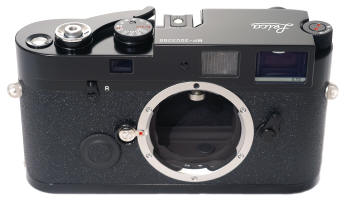 March 1st 2003 at PMA in Las
Vegas, Leica officially announced the new MP, with a MAP for the body of only $2595
at that time.
Two versions were introduced initially, a special edition 400 camera run MP6 for the
Asian market, and a regular production MP.
See MP Page Imagine the
classic M6 w/o TTL flash metering, the M6 Classic style shutter speed dial which
turns in the opposite direction of the M6 TTL and M7, an old fashioned M3 style
rewind knob which you can upgrade to the pleasures of a rewind lever for the
small sum of only $175 with the new Leica M-Rewind Crank, all metal M3 style
advance lever, real brass top and bottom plates with real engraved Leica
script style lettering -- that's pretty much the new MP.
Initially it will be offered in a beautiful black paint finish for the .72
finder, with silver chrome available with your choice of .58, .72, and .85
finder magnifications. Serial numbers start with "MP." The
black paint .72 will likely become the most popular new MP. Real
world, the MP has proven very popular, perhaps the result of pent up demand for
higher quality mechanical fit and finish. Until September 2004 at
Photokina, standard issue MP's were offered in your choice of .58, .72, and .85
finders. After Photokina 2004, the only standard production choice was the .72.
The .58 and .85 finders became available only thru Leica's more expensive new
"a la carte"
program.
March 1st 2003 at PMA in Las
Vegas, Leica officially announced the new MP, with a MAP for the body of only $2595
at that time.
Two versions were introduced initially, a special edition 400 camera run MP6 for the
Asian market, and a regular production MP.
See MP Page Imagine the
classic M6 w/o TTL flash metering, the M6 Classic style shutter speed dial which
turns in the opposite direction of the M6 TTL and M7, an old fashioned M3 style
rewind knob which you can upgrade to the pleasures of a rewind lever for the
small sum of only $175 with the new Leica M-Rewind Crank, all metal M3 style
advance lever, real brass top and bottom plates with real engraved Leica
script style lettering -- that's pretty much the new MP.
Initially it will be offered in a beautiful black paint finish for the .72
finder, with silver chrome available with your choice of .58, .72, and .85
finder magnifications. Serial numbers start with "MP." The
black paint .72 will likely become the most popular new MP. Real
world, the MP has proven very popular, perhaps the result of pent up demand for
higher quality mechanical fit and finish. Until September 2004 at
Photokina, standard issue MP's were offered in your choice of .58, .72, and .85
finders. After Photokina 2004, the only standard production choice was the .72.
The .58 and .85 finders became available only thru Leica's more expensive new
"a la carte"
program.
Why call it the MP? Leica originally made the now rare classic Leica MP (M Professional) in 1956. I for one will call this camera the "MP 2003" to avoid confusion with the original MP. The new MP stands for "Mechanical Perfection" according to Leica. Sounds like some ad guy who didn't have a clue about Leica history had a bad day, to me. Leica also re-introduced the bottom trigger operated Leicavit M (in either black paint or silver chrome) after an absence of only almost half a century. The new Leicavit M has a MAP (Minimum Advertised Price) of only $995 -- or twice that of the superbly reliable Abrahamsson Rapidwinder (which works in the same way). Contrary to hopes of the Rapidwinder fans, the new Leicavit M is a new Leica design not made by Tom Abrahamsson.
Despite the higher cost of the MP over the M6 TTL, I believe it's remarkable Leica finally upgraded the fit and finish of the mechanical M camera to approximate M4 levels. The better finish, brass top and bottom plates, black paint finish, "classically correct" turning shutter speed dial, and engraved Leica script are simply wonderful in the context of the Leica finally returning to the high finished camera standard Leica cameras of old. As a shooter, Leica really blew it with the slow old fashioned M3 style rewind knob, even if the problem is partially cured with the badly designed $175 rewind crank accessory. On the other hand, as a limited production camera it would readily fill collector's shelves. The Fix? A new version with M4 rewind lever. Time will tell. Nevertheless, it is a damn good thing the new Leica M turned has the traditional mechanical shutter, instead of a stripped down M6 shutter with no AE, as was strongly rumored. The mechanical shutter Leica rangefinder stays in production after the announced end of the M6, I am very happy about that. The traditional back to classic MP is proving very popular. Some sales areas are even having difficulty supplying demand. Unfortunately Solms management has yet to get picture and return to the traditional vulcanite body covering. The MP introduces yet another body covering, this variation looks like a $1 sheet of black wet/or/dry sandpaper. Geez. When are these guys going to get it right?
October 2003. A new LHSA MP made in grey hammertone, with matching Leicavit MP and 35/2 is confirmed. Predicted production 1000, commemorating LHSA 1968-2003. Available January 2004. The hammertone is a particularly handsome finish and should be very popular with collectors. I think this camera will be one of the best looking Leicas ever. It has proven one of the most popular Leicas.
October 2003. A new chrome Hermes MP with chrome 35/2 and red leather became available. Production 500 units. If I am reading the press release right, this may be the first of a yearly Hermes Leica, as the French luxury company is Leica's largest stock holder. I hope they do a better job on next year's Hermes Leica. This one is badly over priced, and rather plain without the traditional Leitz style top engraving, NO Hermes engraving on the back of the top plate (what were they thinking?), and rather garish reddish body leather. What is right is 1) a bound book style instruction book 2) a magnificent thick chrome body cap 3) a very well done heavily chrome lens shade. Still, if you are looking for good Leica investments, look elsewhere. This one is overpriced and more than a bit garish to my eyes. ugh.
Leica 50th Anniversary MP grey chrome Anthracite Titanium was made for the Japanese home market. 400 were produced with matching Leicavit and 35/2, with 200 more bodies only. It has a .72 finder, and classic old style vulcanite body covering. The box is clearly labeled "Leica M Series 50th Anniversary Model" but unfortunately the body has no such engraving. It's a beautiful camera, but why no 50th engraving on the body and winder? Because the 50th engraving was reserved for the big dog, the 50th Anniversary titanium M7. Only a handful of the Japanese 50th MPs were officially imported into the USA with USA warranty.
October 2004: Leica's "a la carte" program allows buyers to customize the MP with such features as the M7 rewind, choice of body coverings, choice of finder magnifications, and finish. A good idea in principle, it unfortunately adds quite a few dollars for the trouble. However, this program finally allows the rank and file to order a black paint MP or M7, with vulcanite body covering and Leica script top plate engraving, and even a rewind lever for the MP! Not bad. If you buy the a la carte MP, I strongly urge you to order the lever rewind!
MP "Classic" February 2005 Schmidt Marketing, Leica's Hong Kong distributor, had the interesting idea to produce an MP much close to the original 1957 MP. Schmidt specially ordered 500 to their specifications (hey, you can too, if you have that kind of bucks). 400 were intended for the China market, 100 for the rest of the world. The MP Classic is a nice looking camera with M3 style vulcanite, M3 style engraving, original MP style number, a MP 2004 style film reminder, a beautiful 1957 style rigid black paint 50/2 Summicron, and even has a 1957 MP style TTL metering. In other words, Schmidt thought it a good idea to order 500 cameras without a meter for only about $6500. I see the logic, but I personally think having no meter in this otherwise nicely done camera was a terrifically bad idea from a marketing standpoint. Time will tell if Leica ends up offering a "MP Modern" meter upgrade kit for the meterless "MP Classic."
September 2005: Leica LHSA MP-3, Solms and LHSA hit a home run with this re-creation of the fabled MP of 1957. 1000 cameras will be made, 500 black paint and 500 chrome, with a retro style 50/1.4 ASPH and Leicavit. .72 finder, 35,50,90 framelines, M2 style film counter and dog eared strap lugs like the original, TTL metering, M6 Leicavit/motor compatibility. As special edition Leicas go, this is one of the best!
MP-3 2006
Leica introduced the beautifully done LHSA MP-3 kits in late 2005 for delivery in 2006. 500 each were produced in black paint and chrome, along with a matching retro styled 50/1.4 ASPH. These amount to the modern MP's restyled to 1956 like the original Leica MP with M2 style film advance and film counter. They are GORGEOUS! Long term I believe they will prove superb collectibles. Three thumbs up!
Leica M8 Digital 2006-
Leica will officially unveil its digital M at Photokina 2006. Time will tell how the faithful respond. The basic problem in the Leica M lineup remains a comparatively inexpensive M body to get new Leica nutz into the Leica M system.
Leica Rumors of our Discontent
One of the favorite Leica past times is rumors of new products. Towards the last quarter of 1996, rumors of a new M6 or M7 were rampant. The M6 rebate helped feed these beliefs since it made sense to clear shelves of old stock before bringing out the new model (s). I believe Leica was definitely planning to introduce new M models, but just as their museum is full of things they almost made, they changed their mind on the last moment.
About the time the Leica M6 rebates started, an Italian Leica dealer announced the impending introduction of these new M versions and started quite a ruckus:
1) A M6E with electronic shutter 2) a M6W with a viewfinder for the 21-50 and 3) a M6T with a viewfinder for the 50-135
In this scenario, the expectation was that the M6E would have an M6J finder with higher magnification for the 35-135 range.
A friend of mine, an American Leica dealer, got an informal confirmation of versions 1-3 above from a Leica bigwig. It was one of those yes, but don't quote me things. I know this person well, and he knows Leica. If he says he got the confirmation, he did--regardless of Leica's public denials.
January 98: With the uncertainty of today's worldwide economies, Leica apparently opted for a minor M6 revision with a modified M6J finder, rather than a major update with loads of investment capital.
Things were looking up for M lovers, but world economies intervened. Since that time, the M6 rebate has been extended three (or 4?) times, Leica has sold a slew of M6's, the Japanese stock market has gone down further, the Thailand and Indonesia stock markets did their version of our 1929 crash, and the dollar remains strong against the yen and mark. Add to that Leica's embarrassment and problems in getting a production R8 motor on the shelves. It's not like motors are a secret technology--everyone else has them after all. Finally in Feb 98, something like a year after introduction, the hunchback of Solms AKA the R8 will have a motor. It makes me wonder what Leica is using for a design and product development department.
In the same time frameline, another Japanese acquaintance told me about the field testing of two different Japanese made M cameras by Ricoh and Minolta. Ricoh and Konica, among others, have recently marketed M mount lenses. I am told that Minolta will soon (1999) be marketing a 20 and 28 M mount lens. While Konica made several prototype M cameras, I have it on good authority that Konica will not market it. And of course, there is the new Yasuhara screw mount camera scheduled for delivery for March 1999 and the new Cosina made Voigtlander BL LTM camera with its much appreciated 15 and 25 LTM lenses. There is speculation Cosina may introduce a new model with rangefinder/viewfinder and M mount later in 1999. We will see. The M bayonet patent expired in November of 1998, opening the door of opportunity for M copies.
July 99 Update: I have informal confirmation from a Japanese industry insider who wishes to remain anonymous that two new noteworthy Japanese Leica mount cameras will be introduced this fall:
Konica M mount camera, called the "Hexar RF." Ricoh is said to be contributing to the design. It has the traditional Leica M-mount, manual focus w/range finder, electronically controlled vertical running shutter, and aperture-priority AE feature. Konica might announce their HEXAR 35mm F2.0 and 50mm F2.0 lenses at the same time. (Konica did introduce the RF, the Ricoh camera, if it was more than a rumor, never made it to production)
Ricoh is said to be helping Konica with the Hexar M. Cash rich in other areas, cameras are more of a hobby with Konica than a serious endeavor. I wonder if the Konica Hexar M will actually make it to market as the Ricoh M. Ricoh has shown some interest in the RF market by selling a 28mm LTM lens. (9/2000) it might have been a prototype, but Ricoh left the 35mm camera business to go all digital
Voigtlander Leica Screw Mount Rangefinder camera, built on the Bessa L body.
October 1999
I previously reported that the M7 had been announced for introduction at the next Photokina in September 2000, based upon what I was told appeared in a German newspaper's interview with Leica's CEO Cohn.
I now have a copy of what I believe is that article, dated May 29th 1999 which appeared in the Frankfurter Allgemeine (a large newspaper with national distribution). A new M is talked about, but this article does not specifically call it a M7.
The article does quote Mr. Cohn as announcing a new M for Photokina 2000. It is vaguely described as an improved version of the present M6, without giving features or an official designation. This might be the M7 or a M6E (the designation on a prototype top plate sold at Christies) or M ?? The article does say the regular M6 will stay in production. It remains to be seen what Leica brings to Photokina in September 2000.
Konica has just introduced a "Hexar RF," an AE Leica M body with built in motor drive, but no TTL flash and a very similar to the M6 viewfinder. See Separate profile. It will be interesting to see how well this new camera will be accepted by Leica Nuts, and whether or not rumors that a different version of the Hexar RF will be marketed as the Leica M7 are correct.
October 1999 Leica Historical Meeting in Chicago, Mr. Cohn is reported as saying there would be more M6 models. He also reportedly insisted that Leica did NOT participate in the Hexar RF project, as Leica declined to. To me at least, this is remarkable news since the Konica RF has so many very obvious similarities to the M6, especially nearly identical rangefinder / viewfinder. If Konica copies much more from Leica, Hexar RF owners will start sending their warranty registration to Solms.
November 1999 -- Rangefinder Renaissance Rumors are rampant in Japan of new rangefinders being readied for market in light of Cosina's outstanding success with the Voigtlander Bessa. More Info:
March 2000 -- M6E for Photokina 2000?? nope Rumors and speculation are high that Leica will introduce a new version M6 with Aperture Priority AE at the next Photokina in September 2000. This may be the camera CEO Cohn was referring to when he was quoted in a German Newspaper last year, see story above.
August 2000 CL2 for Photokina 2000?? nope New rumors from Japan suggest a new Japanese built CL2 compact rangefinder. Presently there is only one Japanese Rangefinder on the market which might fill the bill, with a M mount and a Leica name tag, the Cosina made Voigtlander Bessa R. latest Tokyo rumor (9/2000) is that this project was dropped, with Leica and Cosina instead exploring the possibility of a Cosina made electronic M7. Alas, the Leica long time faithful would never fully accept such a Japanese camera as the "big" M body, unless Leica and Cosina management had the foresight to manufacture it in Germany. Hard to believe they would go to the extra expense, but it would probably mean a big difference in sales. Since it would probably require a new factory, this might be the perfect time to add "Wetzlar" once again on Leica top plates. Not likely I know, but time will tell.
September 2000 .58 M6 TTL for Photokina: New rumors, so strong it seems to be all but officially confirmed, is that a new lower magnification .58 finder with 28, 35, 50, 75, 90 framelines will be introduced at Photokina on September 30th. It's for eyeglass wearers who can not see the edges of the wide angle framelines with the .72 finder. Rumor confirmed, introduced at Photokina. It soon became very popular with 35 and 28 lens lovers who want to easily see the framelines. Of the 3 M mount cameras which have visible 28 framelines visible for eye glass users, the Minolta CLE, the Konica Hexar RF, and the .58 Leica M, the .58 has by far the superior finder in my opinion. But don't take my word, try your own side by side comparisons.
September 2000 New M motor at Photokina: Leica finally introduced a better designed M6 motor. It is has a compact design with built in grip, with a choice of single advance, or continuous 1.5 or 3 fps, and unfortunately not powered by standard AA batteries. I would have preferred a metal rather than plastic housing.
June 2001: New 21-28 Zoom finder: While rather large, it does do the job, though separate brightlines offer a better image. This is a unique product, never made by Leica, or any other RF manufacturer before. It's great to see Solms turning out an unusual product like this. Yes, I know about the old Canon V zoom wide angle finder, but it needed an attachment and was not dedicated to these focal lengths. Alas, it is a bit big for my tastes, and it has no brightlines. Something else that bothers me for the price is the "Made in Japan" on the baseplate. It is not proving popular, with many for sale second hand by disappointed owners.
2001: 1.25x M Eyepiece Magnifier: This a real neat new and useful accessory. Since its introduction, this relatively expensive $225 magnifier has proven extraordinarily popular, so popular there has been a shortage of them. Add it to a .58, and it becomes a .72. Add it to a .72, and it becomes a .9. Add it to a .85 and it becomes a 1.06. This is one of Leica's best accessory products ever. BUY IT.
January 2002: M7 The Leica M7 was introduced at the Florida PMA show in February 2002. Retail price for the body is about $2300. It's evolutionary, not revolutionary. Leica makes haste slowly, but it is a very nice camera. The very ODD thing about the M7 is that Leica users who for years swore they did not need AE operation (because it was not available with a Leica M top plate), are now flocking to buy it. HA HA, so much for Leica user "objectivity."
March 2003: MP: The traditional mechanical shuttered beautifully finished M returns to Leica's lineup as a standard camera, at a higher price than the M7.
Keeping your M in nice shape will pay off when you eventually sell it or trade it in. Trashing them photo-journalist style just never made any financial sense to me, besides, why destroy art?
Keeping M's in expensive cases or "Leica" bags is like asking thieves to rip you off. Unassuming bags or old suitcases with foam cutoffs may save your proverbial Leica.
One of the best camera cases is the Samsonite baggage with the wheels and extendable handle--the kind you often see flight attendants use. These don't look like camera bags and do a great job of disguising your expensive equipment. They might also save you back surgery when bringing along 4 bodies with a dozen lenses. Either put your regular bag(s) inside it like I do, or customize it with inserts.
Bragging about your Leica is another questionable practice. The more people believe that you have a funny old fashioned camera because you can't afford a new one, the less chance you have of getting a gun shoved in your face to relieve you of it.
The bottom plate is easily scarred, but also easy to protect. One strategy is to replace it with a scarred user which pops up at camera shows from time to time. Another way is to cut out the adhesive anti skid material which is made for stairs applications. Cut it out to size, and it does a fine job. Cheap too.
The top plate and sides can be protected with black tape if you think you will be shooting in a troublesome environment.
UV Pens will invisibly write your SS# or Driver's License number inside the baseplate and backdoor. Good for ID at Police Departments.
Black electricians tape is a cheap, easy way to protect your black M. Tape over the bottom plate, the ends of the top plate, the various Leica engravings, and that all too bright Red Leica logo that can be seen from the Space Shuttle in orbit.
One Photog told me that anyone who tried to steal his M would have to fight for it. Not me. Dead photogs don't take many pictures.
Meters ? Who needs a stinking light meter ?
Which Leica M's have built in TTL meters? The M5, CL, M6, M6 TTL, M7, and the new M6 MP. The M5 and CL take the meter reading with a moving CDS cell which mechanically moves into the center of the film plane every time you advance the film, and then swings back down out of the way just before the shutter curtains opens. The M6, M6 TTL, M7 and M6 MP have silicon metering cells which read reflected light off the white spot on the first shutter curtain. The M6 TTL and M7 have a basic sort of TTL flash (basic compared to the matrix multi segmented TTL flash systems in Nikon, Canon, Minolta SLRs). The Leitz-Minolta CL and Minolta CL are the Leica CL, but with another nametag.
The other M's, the M3, M2, M4, M4-2, M4-P don't have built in meters, but will take small accessory meters on their top deck. Some people like the various Leica MR meters, made for that purpose. Personally, I don't. I don't like the readouts and I don't like how easy it is to scratch the M's top plate while removing or installing it. My favorite add on meter is the Voigtlander VC meter, and its replacement the VC II, which are very small, and quick and easy to use. In 2005 a special edition black paint MP Classic was introduced, with classic 1950'styling and NO meter.
Other non Leica cameras with Leica M mount and TTL metering, include the Minolta CLE and the Konica Hexar RF. Unfortunately the Hexar does not have a 100% Leica compatible mount, unless it has been altered after leaving the factory. Both of these cameras have aperture priority AE. The CLE goes one better by also having TTL flash. A new low cost M mount camera was introduced by Cosina in 2001, the Voigtlander Bessa T. It was followed by the more advanced Voigtlander Bessa R2 in 2002, and the AE Bessa R3A and R2A in December 2004, and the Zeiss Ikon in late 2004.
By way of comparison, the ONLY Leica screw mount cameras with TTL metering are the Voigtlander Bessa L, aka the Cosina SW-107 which is a Bessa L with a different top plate, the Voigtlander Bessa R, the Yasuhara, and the Phenix JG-50, a Yasuhara for the Chinese market.
Am I right? Always and never, sometimes and maybe
Before I get needless flame mail, let me say that I claim no truth in the above Buyer's Guide. I only hope my not so objective opinions may help you in choosing your own path to Leicadom.
Revised: June 30, 2011 . Copyright � 1997-2011 Stephen Gandy. All rights reserved. This means you may NOT copy and re-use the text or the pictures in ANY other internet or printed publication of ANY kind. Information in this document is subject to change without notice. Other products and companies referred to herein are trademarks or registered trademarks of their respective companies or mark holders.